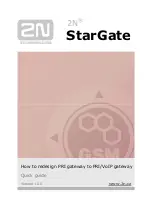
SIP User's Manual
92
Document #: LTRT-68808
Mediant
2000
ini File Field Name
Web Parameter Name
Valid Range and Description
Incoming Calls Behavior
[ISDNInCallsBehavior]
This is the bit-field used to determine several behavior options that
influence how the ISDN Stack INCOMING calls behave. To select
the options, click the arrow button, and then for each required option,
select 1 to enable. The default is 0 (i.e., disable).
[32]
DATA CONN RS = Sends a CONNECT (answer) message
on NOT incoming Tel calls.
[64]
VOICE CONN RS = device sends a CONNECT (answer)
message on incoming Tel calls.
[2048]
CHAN ID IN FIRST RS = Sends Channel ID in the first
response to an incoming Q.931 Call Setup message. Otherwise,
the Channel ID is sent only if the device requires changing the
proposed Channel ID (default).
[8192]
CHAN ID IN CALL PROC = Sends Channel ID in a Q.931
Call Proceeding message.
[65536]
PROGR IND IN SETUP ACK = Includes Progress
Indicator (PI=8) in Setup ACK message if an empty called
number is received in an incoming SETUP message. Applicable
to overlap dialing mode. The parameter also directs the device to
play a dial tone (for TimeForDialTone), until the next called
number digits are received.
[262144]
= NI-2 second redirect number. You can select and use
(in INVITE messages) the NI-2 second redirect number if two
redirect numbers are received in Q.931 Setup for incoming Tel-to-
IP calls.
Note:
When using the
ini
file to configure the device to support
several ISDNInCallsBehavior features, add the individual feature
values. For example, to support both [2048] and [65536] features,
set ISDNInCallsBehavior = 67584 (i.e., 2048 + 65536).
General Call Control Behavior
[ISDNGeneralCCBehavior]
Bit-field used to determine several general CC behavior options. To
select the options, click the arrow button, and then for each required
option, select 1 to enable. The default is 0 (i.e., disable).
[2]
= data calls with interworking indication use 64 kbps B-
channels (physical only).
[8]
REVERSE CHAN ALLOC ALGO = Channel ID allocation
algorithm.
[16]
= The device clears down the call if it receives a NOTIFY
message specifying 'User-Suspended'. A NOTIFY (User-
Suspended) message is used by some networks (e.g., in Italy or
Denmark) to indicate that the remote user has cleared the call,
especially in the case of a long distance voice call.
[32]
CHAN ID 16 ALLOWED = Applies only to ETSI E1 lines
(30B+D). Enables handling the differences between the newer
QSIG standard (ETS 300-172) and other ETSI-based standards
(ETS 300-102 and ETS 300-403) in the conversion of B-channel
ID values into timeslot values:
1) In 'regular ETSI' standards, the timeslot is identical to the B-
channel ID value, and the range for both is 1 to 15 and 17 to 31.
The D-channel is identified as channel-id #16 and carried into the
timeslot #16.
2) In newer QSIG standards, the channel-id range is 1 to 30, but
the timeslot range is still 1 to 15 and 17 to 31. The D-channel is
Summary of Contents for Mediant 2000
Page 1: ...Document LTRT 68808 November 2008 User s Manual Version 5 6 ...
Page 2: ......
Page 18: ...SIP User s Manual 18 Document LTRT 68808 Mediant 2000 Reader s Notes ...
Page 254: ...SIP User s Manual 254 Document LTRT 68808 Mediant 2000 Reader s Notes ...
Page 334: ...SIP User s Manual 334 Document LTRT 68808 Mediant 2000 Reader s Notes ...
Page 342: ...SIP User s Manual 342 Document LTRT 68808 Mediant 2000 Reader s Notes ...
Page 408: ...SIP User s Manual 408 Document LTRT 68808 Mediant 2000 Reader s Notes ...
Page 414: ...SIP User s Manual 414 Document LTRT 68808 Mediant 2000 Reader s Notes ...
Page 418: ...User s Manual Version 5 6 www audiocodes com ...
















































